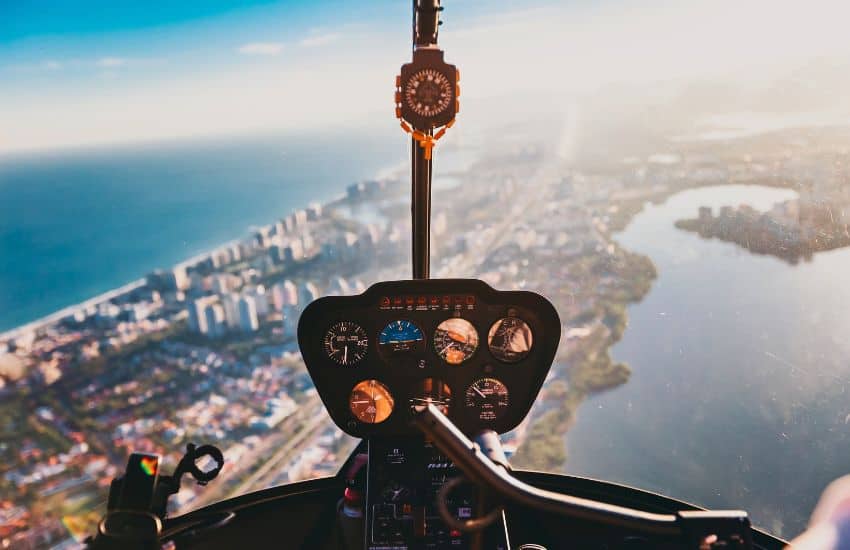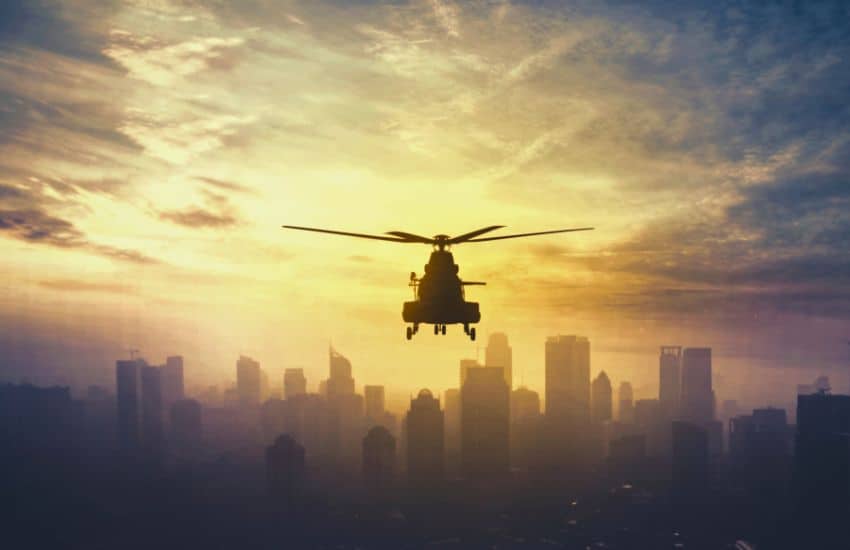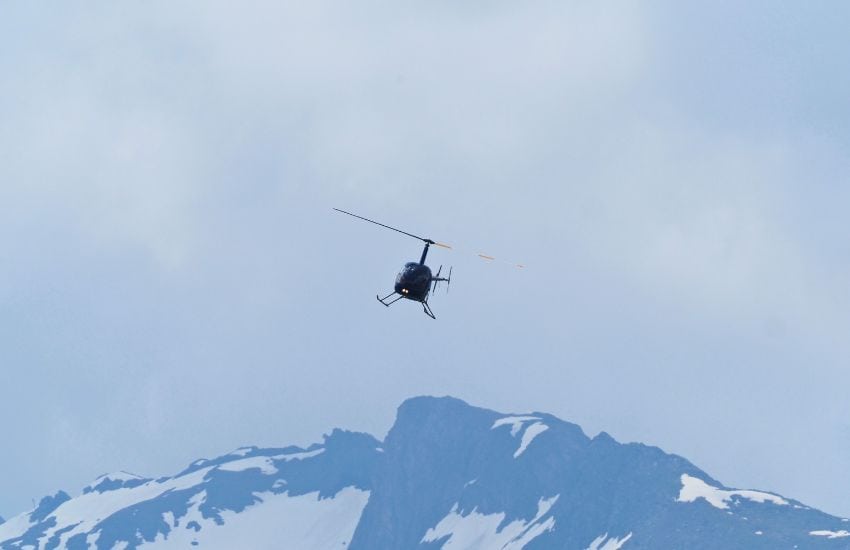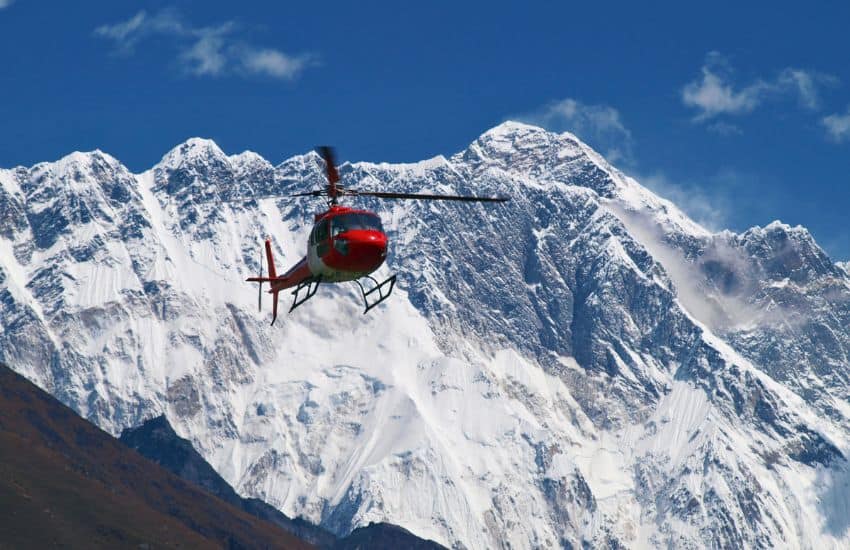As the world stretches skyward and our fascination with aviation reaches new heights, the helicopter is a modern marvel that defies gravity and expectations. With their distinctive rotor blades slicing through the air, these aerial wonders have a unique ability to access the inaccessible, from skyscrapers to mountaintops.
But just how high can a helicopter fly? Buckle up and find out as I present you with the facts. I’ll unveil the incredible heights helicopters can attain but also reveal the surprising ways they’re reshaping our relationship with the skies.
Height Limits by Make and Model
| Model | Use | Altitude Limit |
| CH-47 Chinook | Military | 20,000 feet/
6,096 meters |
| Mosquito XE | Private | 500 feet/
1521 meters |
| AH-64 Apache | Military | 15,000 to 20,000 feet
(4572 to 6096 meters) |
| Sikorsky UH-60 Black Hawk | Military | 15,000 feet/
4,572 meters |
| UH-60L Black Hawk | Military | 15,000 feet/
4,572 meters |
| HH-60M MedEvac Black Hawk | Military | 15,000 feet/
4,572 meters |
| MH-60L DAP Black Hawk | Military | 15,000 feet/
4,572 meters |
| Bell UH-1 | Military/Civilian | 14,000 to 15,000 feet
(4,267 to 4,572 meters) |
| Bell UH-1H Iroquois | Military/Civilian | 12,000 to 15,000 feet
(3,657 to 4,572 meters). |
| Bell UH-1N Twin Huey | Military/Civilian | 10,000 to 12,000 feet
(3,048 to 3,657 meters). |
| Bell UH-1Y Venom: | Military/Civilian | 20,000 feet/
6,096 meters |
What determines how high a Helicopter can fly?
The maximum altitude achievable by a helicopter remains a confluence of elements, encompassing its intrinsic blueprint, the sheer might of its propulsion, and the ever-fluctuating environmental dynamics.

Propulsion Potency
The lifeblood of helicopter flight resides in its engine/s, serving as the relentless force that propels it skyward and maintains its midair trajectory. Engines of augmented potency are the vanguards of soaring altitudes, endowing helicopters with the thrust requisite for scaling celestial heights. In this contemporary era, turbine engines reign supreme, furnishing the indispensable might needed for high-altitude aerial maneuvering.
Burden and Cargo
The aggregate heft of the helicopter, encompassing its core weight, the precious cargo of fuel, the flight crew, and any passengers or cargo, wields substantial sway over its capacity to ascend into rarefied stratospheres. Helicopters constructed with aspirations of high-altitude forays often find themselves shackled by reduced payload quotas in light of the demands for power and fuel attendant to loftier altitudes.
Rotor
The technology ingrained in the configuration of a helicopter’s rotor blades and their prowess in sculpting lift is paramount in the quest for loftier altitudes. Rotor blade optimization for high-altitude feats calls for meticulous considerations, encompassing fine-tuning of blade geometry, choice of materials, and the recalibration of rotor rotation velocities.
Altitude Performance Graphs
Proprietors of helicopters proffer charts of altitude performance, delineating the ascent achievable under varied circumstances, including ambient temperature and laden weight. These visual aids furnish pilots with the guidance requisite for navigating safely within the craft’s operational zenith.
Meteorological Nuances
With each surge in altitude, the density of the surrounding air undergoes a gradual thinning, a transformation that significantly shapes both lift production and engine efficacy. As the ascent progresses, the aerial medium becomes progressively thinner, culminating in a shortage of oxygen essential for the combustion process within the engine. This regression triggers a decrease in engine thrust and rotor efficiency. In effecting high-altitude missions, the deployment of specialized equipment and the execution of tailored adjustments become imperative in offsetting these pervasive challenges.
Temperature
As altitudes increase, the paradigm frequently dictates a diminution in temperature, a factor profoundly influencing the engine’s comportment and the helicopter’s ascension potential. The frigid atmosphere at lofty elevations bestows an increased density, a boon for lift generation but a potential stumbling block for engine performance.
Helicopter Type
Certain helicopter models are tailored explicitly for elevated altitudes, most notably those earmarked for deployment in the mountainous terrain by military establishments. These specialized options boast amplified engine acumen and rotor configurations honed to enable them to operate with finesse at the zenith of the Earth’s exosphere.
Aeronautical Proficiency and Training
The quintessence of how high a helicopter may safely ascend lies within the pilot’s skill and preparatory training. Navigating the realm of lofty altitudes demands acumen that is acutely calibrated to confront the unique tribulations of waning engine vigor and the diminishing lift capacity experienced at higher altitudes.
How High Do Helicopters Usually Fly?

The typical cruising altitude for most helicopters is 10,000 feet/3,000 meters above sea level. However, the specific height at which a helicopter operates can differ depending on its type, mission, and environmental conditions.
Many low-level flying helicopters, especially those used for tasks like police work, medical transport, and utility transports, fly at relatively low altitudes, often below 1,000 feet/300 meters. It helps them to navigate urban areas, avoid airspace congestion, and access landing zones in various locations.
Recreational Helicopter height limit
Now, recreational and private helicopters typically operate at altitudes between 1,000 and 5,000 feet (300 to 1,500 meters). This range provides flexibility for scenic flights, short trips, and local transportation.
On the other hand, commercial helicopters, such as those used for tourism or shuttle services, may operate in the same altitude range as private helicopters, generally below 5,000 feet. Larger transport helicopters, like those used for offshore oil rig support or intercity transport, may fly up to 10,000 feet/3,000 meters.
Military Helicopters height limits
For military helicopters, they can operate at a wide range of altitudes, depending on their mission. Some military helicopters are designed for high-altitude tasks and can fly well above 10,000 feet, while others are designed for low-level and close air support missions. Some helicopters are specifically designed for high-altitude, like the ones used for mountain rescue or high-altitude reconnaissance. And they are equipped to handle the challenges posed by high altitude.
Additionally, helicopters can reach higher altitudes for short durations during takeoff, landing, or specific mission requirements, but they typically cruise within the heights mentioned above.
What Happens If A Helicopter Flies Too High?
Wondering what happens if a helicopter flies too high? Here are some facts about what happens.

Reduction in engine power
One of the foremost concerns when flying a helicopter at excessive altitudes is the reduction in engine power. As you ascend to higher heights, you’ll notice a distinct change in the air around you. The air becomes thinner, meaning there’s less oxygen available for combustion in the engine. Consequently, your helicopter’s engine begins to lose power, leading to a drop in performance. You may find it increasingly challenging to maintain your current altitude or execute a further climb. Worse yet, there’s an elevated risk of engine failure, which is a scenario you certainly want to avoid.
Decrease in lift
Simultaneously, as you ascend to great heights, you’ll encounter a decrease in lift generation. Helicopters depend on their rotor blades to create lift by pushing air downwards. At higher altitudes, the reduced air density makes it more demanding for your rotor blades to generate the necessary lift. It results in a drop in lift capacity, making it challenging to hover or maintain your desired altitude. The relationship between altitude and lift becomes a critical factor that you must monitor vigilantly.
It’s important to remember that every helicopter has a maximum altitude specified by the manufacturer. Beyond this point, you begin to venture into dangerous territory. Attempting to fly your helicopter above its maximum altitude limit could lead to catastrophic outcomes, including a loss of control, heightened stall risk, and the potential for other aerodynamic problems. The manufacturer’s guidelines exist for a reason, and it’s crucial to respect them to ensure the safety of your flight.
Less oxygen
At great altitudes, there’s a concern related to oxygen levels and the potential for hypoxia. As you climb, the atmosphere contains less oxygen, putting you and your passengers at risk. Hypoxia, a condition resulting from oxygen deficiency, can affect cognitive abilities. You may experience impaired judgment, confusion, and even a loss of consciousness. To mitigate this risk, helicopters designed for high-altitude operations are equipped with supplemental oxygen systems. Utilize these systems to safeguard yourself and your passengers.
Low Temperatures
Additionally, the lower temperatures associated with high altitudes can lead to ice formation on your helicopter’s surfaces, especially on the rotor blades. This ice accumulation disrupts the aerodynamics of the blades, reducing lift and potentially causing instability or control issues. You’ll need to be vigilant about monitoring and mitigating ice-related challenges during your high-altitude flights.
Increased turbulence
Another concern when flying at great heights is the potential for increased turbulence. Turbulence can become more pronounced in mountainous regions or near high terrain. This turbulence can test your piloting skills and your helicopter’s stability. Furthermore, the weather conditions at high altitudes can change rapidly, making it challenging to anticipate and respond to environmental shifts.
Less room for error
Finally, when you push your helicopter to its maximum altitude, you leave little room for error. The margins for safety and performance become narrower. Any sudden changes in conditions or pilot inputs can heighten the risk of instability, stall, or other aerodynamic issues.
How high can a helicopter fly on Everest?
Helicopters can ascend to notable heights, and they have found utility across a range of applications on Mount Everest, the Earth’s loftiest peak. Nevertheless, their operational ceiling is constrained by the rarified atmosphere and diminished oxygen levels at high altitudes.
The maximum elevation achievable by a helicopter on Mount Everest hinges on various variables, encompassing the helicopter model, prevailing weather conditions, and the cargo it carries. Below are several instances of helicopter tasks performed on Everest:

- High-Altitude Rescues: Helicopters are frequently deployed in high-altitude search and rescue missions on Everest, typically functioning up to an altitude of around 23,000 to 24,000 feet (7,000 to 7,300 meters). At these heights, the air is notably thin, and helicopters may encounter difficulties generating adequate lift to remain airborne and transport substantial payloads.
- Everest Base Camp: The Everest Base Camp, positioned at roughly 17,600 feet/5,364 meters, is a hotspot for helicopter activities. At this elevation, they can fly comfortably and are employed for conveying climbers, provisions, and gear to/from the base camp.
- Higher Camps: On occasion, helicopters visit higher camps on Everest, such as Camp 2 (21,300 feet or 6,500 meters) or even Camp 3 (24,500 feet or 7,470 meters). However, operations at these levels are formidable, and they typically skip carrying heavy loads to reach these locations.
- Cargo Restrictions: With increasing altitude, helicopters are burdened by decreasing payload capacity. As they ascend, the challenge of generating sufficient lift to stay aloft intensifies. Consequently, helicopter operators must meticulously assess the aircraft’s weight and balance to ensure secure operations at high altitudes.
It’s important to emphasize that helicopter flights on Everest are fraught with risk due to the extreme conditions, volatile weather, and the intricate demands imposed by high-altitude endeavors. Pilots and operators must possess extensive experience and the requisite equipment to navigate these trials. Furthermore, there is a defined altitude limit for helicopter operations on Everest, preventing them from reaching the summit due to the exceedingly high elevation and thin atmosphere.
Helicopter activities on Everest are often confined to specific elevation ranges, and aviators and crew are adept at managing the unique intricacies of flying in this elevated environment.
How high can a Chinook helicopter fly?
The CH-47 Chinook helicopter is used by the United States military and many other armed forces globally due to its versatility in heavy-load transport. Generally, a Chinook helicopter can operate at altitudes up to 20,000 feet (6,096 meters) above sea level, depending on the abovementioned factors. This altitude is well-suited for a wide range of military and civilian missions. However, the helicopter’s practical operational ceiling is often lower than its theoretical maximum altitude due to mission-specific requirements and safety considerations.
How high can a Mosquito helicopter fly?
The Mosquito helicopter, a lightweight, single-seat, and often home-built rotorcraft, is typically designed for low-altitude flight. The maximum altitude a Mosquito helicopter can reach can vary depending on several factors, including the specific model, engine, and modifications made to the aircraft.
Mosquito helicopters are not designed for high-altitude flight. They are primarily intended for recreational and short-distance flying at lower altitudes. The maximum altitude for a typical Mosquito helicopter is usually limited to roughly 500 feet/1521 meters above ground level like the XE.
How high can an Apache helicopter fly?
The AH-64 Apache helicopter is a special kind that’s good at doing different tasks like helping soldiers, fighting tanks, and finding out what’s happening in an area. Now, how high up in the sky it can go depends on a few things, like what type of Apache it is, what the weather is like, and what the mission is.
Usually, an Apache helicopter can go as high as 15,000 to 20,000 feet (4572 to 6096 meters) above the ground. But the exact number can change because of how heavy the helicopter is, what stuff it’s carrying, and how hot or cold it is outside.
How high can a Blackhawk helicopter fly?
The Sikorsky UH-60 Black Hawk can reach depends on various factors, including its specific model, payload, and environmental conditions. Specifically, Black Hawk helicopters are designed to operate at altitudes of up to 15,000 feet (4,572 meters). However, some variants may have different capabilities.
Here are a few variants of Black Hawk helicopter and their flight height capacities:
- UH-60L Black Hawk: The UH-60L is an upgraded variant with improved engines and other enhancements. It also has a service ceiling of around 15,000 feet.
- HH-60M MedEvac Black Hawk: This model is designed for medical evacuation (medevac) missions. It is based on the UH-60M and has similar performance characteristics, including a service ceiling of about 15,000 feet.
- MH-60L DAP Black Hawk: The MH-60L Direct Action Penetrator (DAP) is a special operations variant with added firepower, typically used for close air support. It also operates at altitudes up to 15,000 feet.
The specific mission and equipment configuration of a Black Hawk helicopter can also influence its altitude capabilities. Some specialized variants may have slightly different performance characteristics to meet their unique operational requirements.
How high can a Huey helicopter fly?
The Bell UH-1 Iroquois, commonly known as the “Huey” helicopter, has a typical operational altitude of around 14,000 to 15,000 feet (4,267 to 4,572 meters) above sea level.
Different engines can affect Huey’s performance. Some Huey helicopters are equipped with more powerful engines, which may allow them to operate at slightly higher altitudes. Some military or specialized variants of the Huey may have modifications that enhance their performance.
In summary, the typical operational altitude of a Huey helicopter is around 14,000 to 15,000 feet, but this can vary depending on various factors. Hueys are versatile aircraft used for a wide range of missions, including troop transport, medical evacuation, and utility tasks, and their altitude capabilities can be adjusted based on the mission requirements and equipment.
Here are some example models of the Bell UH-1 Huey helicopter and their typical maximum operational altitudes:
- Bell UH-1H Iroquois:
Maximum Operational Altitude: Around 12,000 to 15,000 feet (3,657 to 4,572 meters).
- Bell UH-1N Twin Huey:
Maximum Operational Altitude: Approximately 10,000 to 12,000 feet (3,048 to 3,657 meters).
- Bell UH-1Y Venom:
Maximum Operational Altitude: Approximately 20,000 feet (6,096 meters). The UH-1Y is a more modern and upgraded variant with improved performance.
What is The Highest Ever Flight in a Helicopter?
In 1972, Jean Boulet and Bernard Ziegler made aviation history by piloting an Aerospatiale SA 315 Lama helicopter to an astonishing altitude of 40,820 feet (12,442 meters). This remarkable feat established a new benchmark as the highest altitude ever attained by a helicopter.
Interested in Helicopters?
Learn more here
How far can a helicopter fly?
Helicopter headset review
What is the fastest helicopter?
How fast does a helicopter go?
How much is a helicopter?
The world of helicopters is a fascinating one, with a wide range of models and capabilities that can take us from the treetops to the mountain peaks. While they don’t match the heights that commercial airliners or spacecraft do, helicopters are crucial in various industries and have a unique ability to access remote and challenging locations.
The next time you look up at the sky and ask yourself how high a helicopter can fly, you’ll have a better appreciation for its remarkable versatility and the heights it can achieve. Whether performing daring rescue missions, aiding in construction, or simply offering a scenic tour, helicopters symbolize human ingenuity and the endless possibilities of flight.
